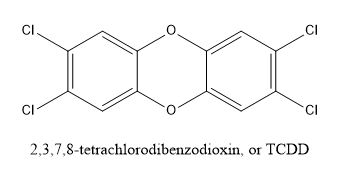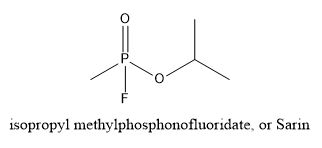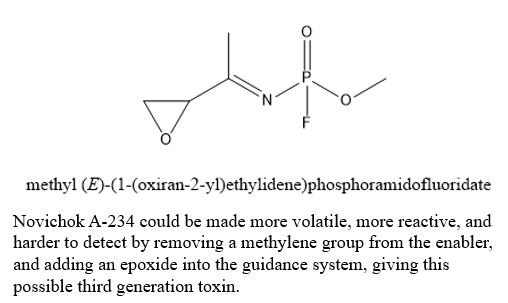 Vladimir Putin is the current totalitarian ruler of Russia, which isn’t in itself an historically surprising circumstance. From the Tsars to the Bolsheviks and on through the present, a single despotic person has generally ruled over Russia, and frequently over a large part of the contiguous territories of Europe and Asia. Unlike Stalin, who was an imposing physical person and who murdered wantonly and in massive numbers, Putin is a small, pale, reptilian person who rules and murders much more after the fashion of a snake. There is a certain morbid fascination in watching a current head of state selecting and deploying a range of improbable toxins against a fairly random list of perceived traitors, enemies, journalists and spies. Poisoning is only an attractive option for murder when one wishes to have plausible deniability, yet Putin’s numerous deployments of poisons to date have been a comedy of errors and uncritical thinking, leaving in many cases a trail of tracks leading almost directly to him.
Vladimir Putin is the current totalitarian ruler of Russia, which isn’t in itself an historically surprising circumstance. From the Tsars to the Bolsheviks and on through the present, a single despotic person has generally ruled over Russia, and frequently over a large part of the contiguous territories of Europe and Asia. Unlike Stalin, who was an imposing physical person and who murdered wantonly and in massive numbers, Putin is a small, pale, reptilian person who rules and murders much more after the fashion of a snake. There is a certain morbid fascination in watching a current head of state selecting and deploying a range of improbable toxins against a fairly random list of perceived traitors, enemies, journalists and spies. Poisoning is only an attractive option for murder when one wishes to have plausible deniability, yet Putin’s numerous deployments of poisons to date have been a comedy of errors and uncritical thinking, leaving in many cases a trail of tracks leading almost directly to him.
Russia’s brief flirtation with democracy ended in the year 2000 with the sudden resignation of Boris Yeltsin followed by the improbable election of Vladimir Putin with a reported 53% majority of the vote. At this time, the most recent known use of poisoning for assassination by Russian operatives was the 1978 killing of dissident Georgi Markov in London. Markov was jabbed in the thigh with a sophisticated umbrella tip injector that deposited a tiny pellet of the biological toxin ricin resulting in his death 3 days later.
Two years after Putin’s ascension to the Russian presidency, his regime was challenged by the 2002 Moscow theater hostage crises when at least 40 armed Chechen rebels seized several hundred hostages and demanded an end to the war in Chechnya. The Russian security forces responded by pumping an aerosolized solution of the μ opioid receptor agonists fentanyl, and/or carfentanyl into the building’s ventilation system, killing all of the rebels and at least 204 of the hostages. These drugs have been developed as useful anesthetic agents and are potentially reversible, but first responders from the FSB who stormed the theater wearing gas masks did not seem to have remembered to bring any of the lifesaving antagonist naloxone with them, resulting in the high civilian death toll.

Yuri Schekochikhin was a 53-year old investigative journalist who was hospitalized suddenly in 2003 with symptoms of heavy metal poisoning, including a peripheral neuropathy. He fell ill just a few days before he was scheduled to fly to the United States to discuss a corruption scandal involving Vladimir Putin with the FBI. Since Schekochikhin was treated at the Central Clinical Hospital in Moscow which is tightly controlled by the FSB, there was never a formal autopsy and his family was denied access to his remains. However, the clinical picture is consistent with an acute intoxication by the toxic heavy metal Thallium. From 2003 through 2004, this seems to have been Putin’s choice of poisons, as it was also implicated in the death of his former bodyguard Roman Tsepov in St. Petersburg. The journalist Anna Politkovskaya was also poisoned with a substance in her tea in 2004, which she survived, only to be gunned down in an elevator in 2006. Thallium was not a new or particularly innovative poison, as it had been tried several times in the preceding decades by a number of governments, including the French, Americans, South Africans and Iraq’s Saddam Hussein.

However, a new poison emerged that same year in the bitterly contested Ukrainian election contest between pro-Russian Viktor Yanukovych, the hand picked favorite of Putin, and Viktor Yuschenko representing the Western-leaning independence parties.
Dioxin

The dioxin molecule, pictured above, was already rather infamous following the accidental 1976 industrial release in Seveso, Italy that sickened thousands of people and killed birds and animals. However, sickened is the operative word here, since although dioxin is toxic, it isn’t very lethal. Yushenko’s poisoners did manage to inflict a painful and disfiguring case of chloracne on him, but he survived. He also provided an impressive number of pharmacokinetic samples to the doctors who treated him, allowing them to work out the metabolism and excretion routes of this compound using only a single, inadvertent human test subject. This peculiar and silly choice of toxins shows Putin for the amateur that he is, but also shows him struggling with an internal conflict. He wants his victims dead, but he cannot resolve whether he wants to kill them secretly and privately, or whether he wants the poison to make it clear that he is the killer and is behind the assassination of each person as the victims fall ill.
The botched poisoning of Viktor Yuschenko dramatized the incompetence that sometimes attends Putin’s attempts to poison for political purposes. However, rather than learning from this, the keystone cops theme expanded with the 2006 poisoning and eventual assassination of Alexander Litvinenko using the powerful radioactive alpha-emitter Polonium 210. In terms of the selection of the poison, this was a much more lethal and effective agent when compared to dioxin. Putin had been in power for 6 years, and must have felt secure enough to turn to the Kremlin’s secretive research institutes for poisoner’s advice. Polonium 210 is an almost ideal radioactive poison. Almost a pure alpha particle emitter, it cannot be detected inside a simple glass vial by conventional radiation detectors. It is estimated to be up to one trillion times more toxic that hydrogen cyanide, also known as prussic acid and the favored poison from more than one hundred years earlier. Once Litvinenko ingested the few micrograms of radioactive metal that killed him, his own body was sufficient to absorb almost all of the emitted radiation, and at first his doctors did not think he had radiation poisoning.

Litvinenko was poisoned in a London sushi shop where he sipped the fatal dose of Polonium 210 in a cup of tea. The FSB agents Andrei Lugovoi and Dmitri Kovtun who carried out the assassination had already left a trail of radiation in the airliner which carried them from Moscow through Berlin to London. They had spilled it in their hotel room and sopped it up with a bath towel. Lugovoi accidently contaminated a strip club and a soccer stadium that he visited on the same trip, and a flat where he stayed in Hamburg, Germany. Due to its unique half life, unusual trace impurities, and the scarcity of nuclear facilities in the world capable of purifying it, the source of the Polonium 210 was directly traced to the Russian nuclear complex in Sarov, about a day’s drive from Moscow.
So while Polonium 210 brought Putin an extremely effective agent, it once again foiled any attempt at secrecy, as it practically fingerprinted Russia, his regime, and him personally as having plotted and carried out the murder.
This brings us to the much more recent and sensational poisonings of Sergei and Yulia Skripal in the town of Salisbury, England, and then the additional accidental poisonings of Charles Rowley and Dawn Sturgess, who blundered into residues of the poison used on the Skirpals in a discarded perfume bottle 4 months later. The poisonings first came to the attention of police on March 4, 2018 when the Skripals were noticed slumped over and unconscious on a public bench. These attacks represented the first open use of an advanced class of nerve gas agents specifically designed as chemical warfare agents in Russia before the collapse of the Soviet Union, called the Novichoks or “Newcomers.”
 This most recent application of chemical weapons for political ends by Vladimir Putin was my inspiration for writing this blog post, since my company Cayman Chemical has a deep working knowledge of the target of these agents, the essential neuronal enzyme acetylcholinesterase (AChE). Acetylcholine is a major neurotransmitter of the central and peripheral nervous systems, controlling many aspects of conscious activity including the activation of the heart, diaphragm and voluntary muscles. AChE acts to terminate these signals so that the system can return to a resting state. Simply put, AChE allows you the delicate motor control to breath in, then out, and to scratch your nose without punching yourself in the face. If AChE is inhibited or blocked, uncontrolled muscular contractions and spasms lead to cardiac and respiratory arrest, and death from circulatory and respiratory collapse soon follows.
This most recent application of chemical weapons for political ends by Vladimir Putin was my inspiration for writing this blog post, since my company Cayman Chemical has a deep working knowledge of the target of these agents, the essential neuronal enzyme acetylcholinesterase (AChE). Acetylcholine is a major neurotransmitter of the central and peripheral nervous systems, controlling many aspects of conscious activity including the activation of the heart, diaphragm and voluntary muscles. AChE acts to terminate these signals so that the system can return to a resting state. Simply put, AChE allows you the delicate motor control to breath in, then out, and to scratch your nose without punching yourself in the face. If AChE is inhibited or blocked, uncontrolled muscular contractions and spasms lead to cardiac and respiratory arrest, and death from circulatory and respiratory collapse soon follows.

Sarin and other classical chemical warfare agents, as well as the advanced Novichok agents deployed in the UK, all act by irreversibly inhibiting AChE, reacting with a critical serine residue in the AChE active site with displacement of the fluorine and formation of an enzyme-phosphonate ester.

Many years ago, we at Cayman Chemical were introducing research tools for inhibiting a different enzyme when we prepared the compound MAFP, shown below. This compound is a potent, selective inhibitor of the cytosolic phospholipase A2 (cPLA2) that releases free arachidonic acid in response to cell signalling in inflammation. The mechanism is precisely the same as a nerve agent, in that the MAFP molecule irreversibly binds to an active site serine in cPLA2 and forms a phosphonate ester by displacement of fluoride.

At the time, we were concerned that this compound might be dangerous, so we performed an LD50 study in mice (unpublished) and found that mice survived the highest dose of 10mg/kg. This and other binding data indicated that MAFP was selectively targeting the cPLA2 enzyme and was not binding to the AChE enzyme as the nerve agents do.
As we look to the future, expect Putin to continue to try to perfect his poisoning as he remains plagued by performance issues with both his toxins and his FSB subordinates.* Look also for further refinement of the Novichok agents, as they proved much too stable, and ironically killed only one of three non-targeted, accidental victims several months after the unsuccessful assassination attempt on the Skirpals. All fluorophosphonates, whether they be pesticides, research tools, or chemical warfare agents, have three functional domains as illustrated below. Improvements could be made to both the enabler and guide, making a newer Novichok evaporate more quickly, polymerize and degrade on environmental exposure, be more difficult to prep for mass spec analysis, and not hang around for 3 months in a perfume bottle. Just sayin’, Vlad.


This brings me to the conclusion of my first blog post for 2019, which will be a remarkable year by any measure. The use of chemical warfare agents should be unheard of, as proscribed in the Geneva Convention, but instead their use sometime in the new year seems likely. Russia and its ally Assad have made them a standard military option in the Syrian civil war, and North Korea joined Putin last year in favoring nerve agents as a method of silencing opposition leaders. The heads of state in some of the most powerful countries in the world seem quite unqualified for such a position. In the United State, we have an ignorant, narcissistic, compulsive liar as our president, who seems likely to ignite conflicts through his sheer stupidity and incompetence. In Russia we have a megalomaniac serial killer who experiments on citizens of other countries with his super-poisons and Machiavellian schemes for world dominance. Strangely, even Great Britain, attacked within the last 12 months, continues to welcome Putin’s attendance at global strategic summits such as the recently concluded G-20 meeting in Argentina. The coordinated public shaming, shunning, and eventual removal from power of Vladimir Putin is the only safe and reliable antidote to any of Putin’s Poisons.



Reblogged this on VIRTUAL BORSCHT.